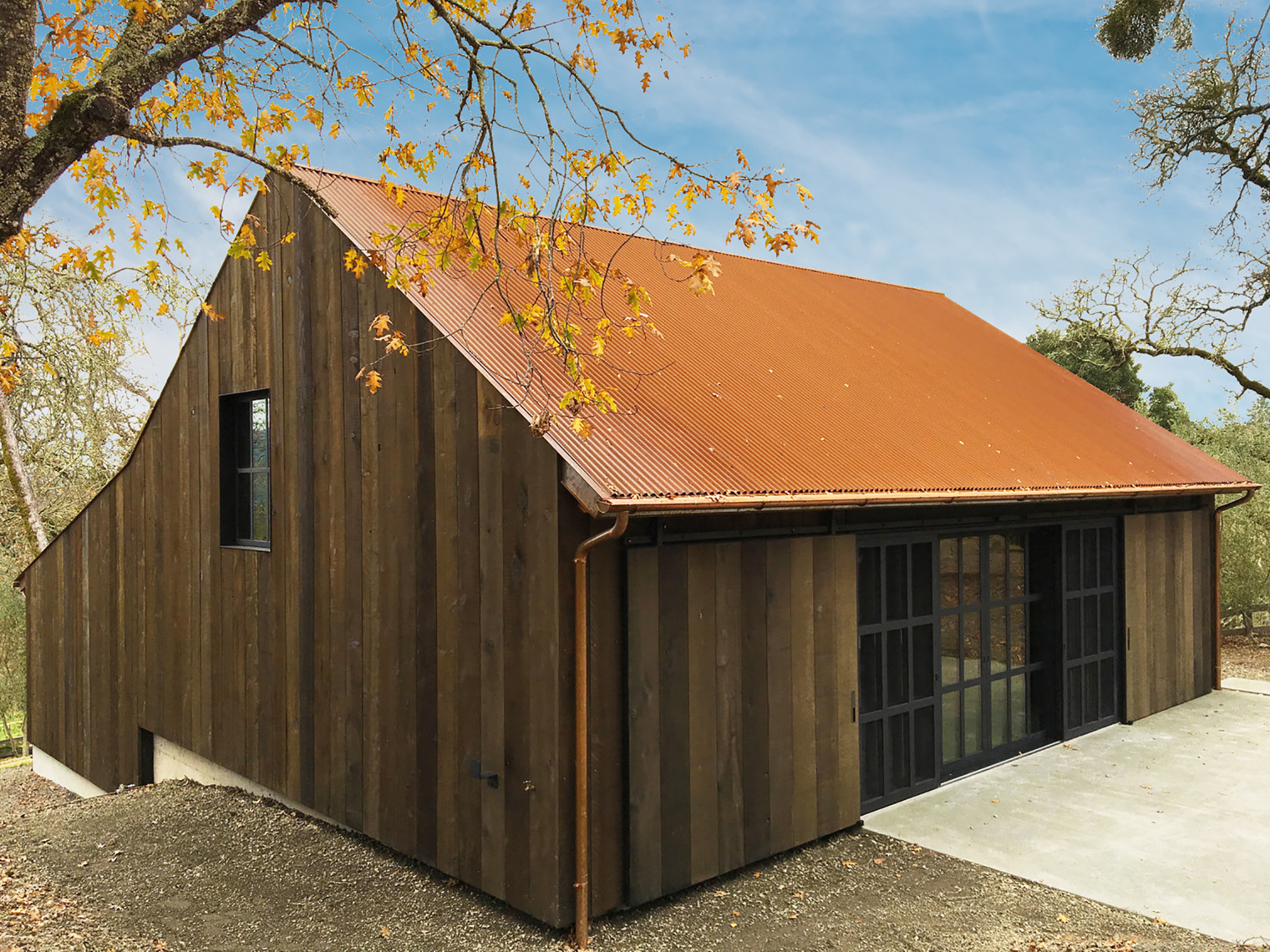Photo courtesy of Propane Education and Research Council
ENERGY CHALLENGES
There have been dramatic improvements in the energy efficiency of buildings over the past two decades. However, energy use for heating and cooling is still a large portion of the total national energy use and provides a significant opportunity for further reductions.1, although it is no longer a majority, energy use for heating and air conditioning still accounts for 48% of the primary energy consumed in United States residences.2 According to the Radiant Professionals Alliance, “Of the roughly 59 billion square feet of total commercial floor space, about 82 percent is heated and 61 percent is cooled.”
When considering net-zero performance goals, improving the energy efficiency of HVAC systems and appliances is critical because of how much energy they consume in buildings. However, designing with standard HVAC systems and appliances would be cost-prohibitive, generating the required energy through on-site renewables.3
Reducing energy needs through efficiency gains is far more practical than making up the remaining energy needs via on-site renewables. Whether designing a standard or net-zero building, propane-fueled hydronic heating systems can accomplish these efficiency gains.
A SOLUTION: HYDRONIC HEATING
According to the Radiant Professionals Alliance, hydronics are heating or cooling systems that transfer energy by circulating a fluid through a network of pipes using mechanical systems, including but not limited to renewable and nonrenewable energy sources, energy recovery, associated equipment, and appliances for space heating and cooling.
In addition to home heating and cooling, hydronic systems can be used for potable and nonpotable water heating, swimming pool or process heating, solar thermal systems, snow melt and frost protection systems, dehumidification, and humidification.4

Photo courtesy of Adobe
It’s important that comfort not be ignored, as even small residential heating systems affect the health, productivity, and comfort of occupants. Properly designed hydronic systems control both the air and surface temperature of rooms, and it’s easier to maintain a comfortable humidity level with hydronic systems.
Hydronic heating systems use hot water and glycol to move heat from where it’s produced to where it’s needed to heat a home or commercial building. The hot water usually comes from a boiler, although it can also come from a tankless water heater or an electric heat pump. Appropriate Designs, a team of engineering professionals dedicated to advancing modern hydronic heating, notes that the system is neither the source of the heat nor its destination, but only its ' “The water with conveyor belt.’
Heat is absorbed by the water at a heat source, conveyed by the water through the distribution piping, and finally released into a heated space by a heat emitter. Modern hydronics technology enables heat to be delivered precisely when and where it is needed.”5
There are two types of hydronic heating: radiant hydronic and forced-air hydronic. Radiant hydronic uses hot water to directly heat the building through radiant floor heating, baseboards, orradiators, while forced-air hydronic uses a hot-water loop in the air handler to heat the air that runs through the building (like a furnace but with hot water instead of gas heat). Heat pumps deliver register temperatures that can feel cool at around 95 degrees Fahrenheit (below human body temperature), but gas furnaces deliver heated air at around 140 degrees. And air handlers with a hydronic heating loop can reach a cozy level of about 130 degrees. We will discuss each of these technologies in more detail in the following learning objectives.
ADVANTAGES OF HYDRONIC HEATING
Hydronic heating has many advantages, including increased comfort, energy savings, and versatility.
Comfort6
Although providing a comfortable environment should be the primary objective of any heating system designer or installer, other factors, such as cost, often compromise this goal. However, comfort should not be ignored, as even small residential heating systems affect the health, productivity, and comfort of occupants for the entire building lifecycle or until a better system is installed.
Unfortunately, we tend to “deal with” uncomfortable heating and cooling systems by wearing layers, using blankets, or compromising our thermal comfort because stasis seems impossible. According to Appropriate Designs, “Often people who have lived with uncomfortable heating systems simply don't realize what they have been missing. In retrospect, many would welcome the opportunity to have truly comfortable buildings and willingly spend more money (if necessary) to achieve it.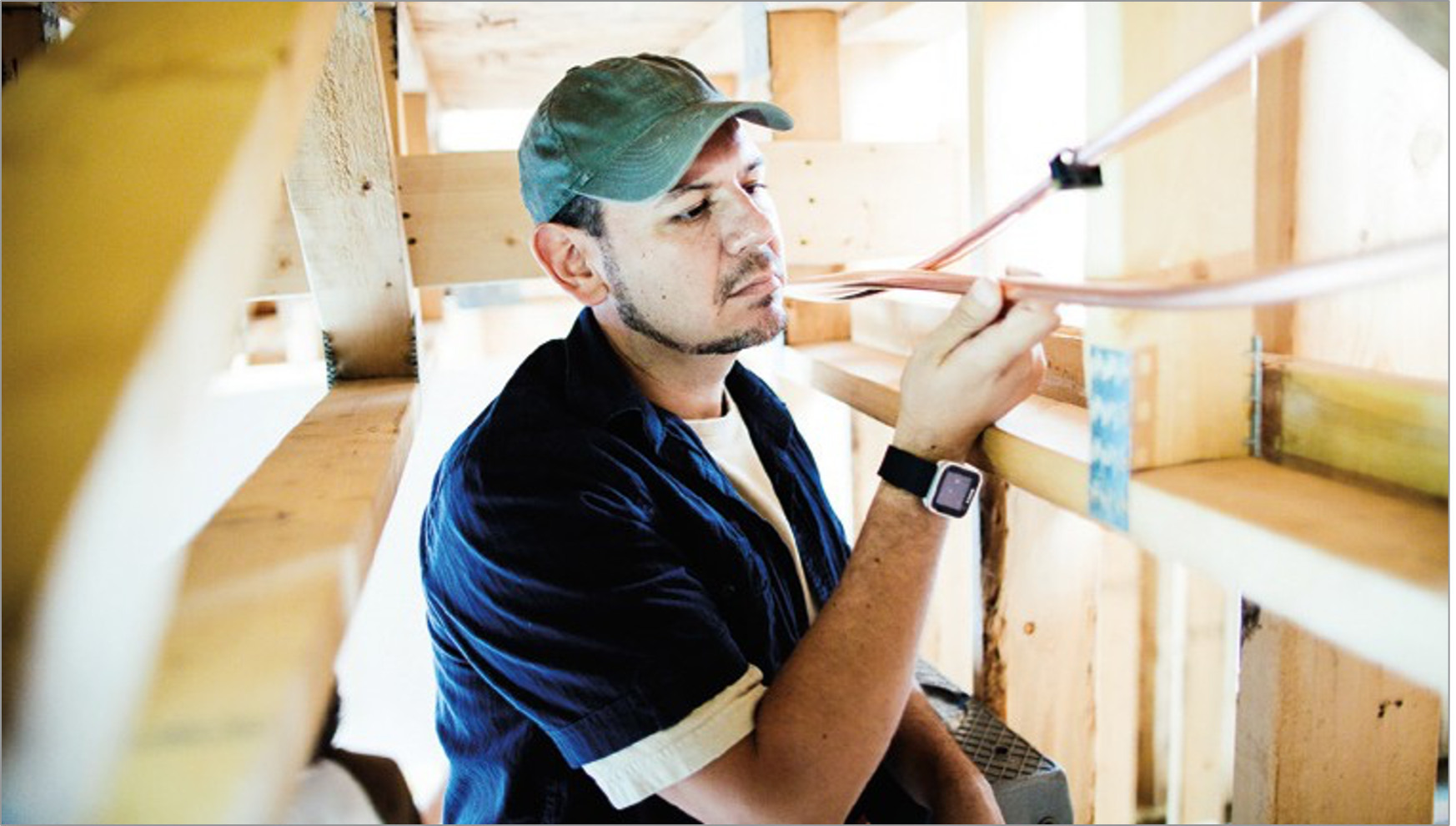
Photo courtesy of Propane Education and Research Council
Hydronic systems can use a wide variety of energy sources to heat the liquid, including standard propane-, gas-, or oil-fired boilers; wood-fired boilers; solar water heaters; or a combination of these sources.
Energy Savings7
Otherwise, identical buildings can have significantly different rates of heat loss based on the types of heating systems installed and how the heat is replaced. Appropriate Designs states, “Buildings with hydronic heating systems have consistently shown lower heating energy use than equivalent structures with forced-air heating systems.
Another factor affecting building energy use is air temperature stratification, which is the tendency of warm air to rise toward the ceiling while cool air settles to the floor. Hydronic systems that transfer most of their heat by thermal radiation reduce air temperature stratification and thus reduce heat loss through ceilings. Comfort can often be maintained when a space is radiantly heated at lower air temperatures.”
Design Versatility
Hydronic heating systems also offer design versatility, with several technologies and many additional options that can change based on building owners' aesthetics, comfort, usage, and budget constraints. A single system can supply space heating, domestic hot water, and specialty loads such as snowmelt systems and pool heating. This reduces installation costs because redundant components such as multiple heat sources, exhaust systems, electrical hookups, and fuel supply components are eliminated.8
Multiple Fuel Sourecs
Most hydronic (liquid-based) systems use little electricity, a benefit for homes off the power grid or in areas with high electricity prices.9 hydronic systems can also use a wide variety of energy sources to heat the liquid, including standard propane -, gas -, or oil-fired boilers; wood-fired boilers; solar water heaters; or a combination of these sources. Compared with oil, propane and gas systems offer better modulation and control that lead to higher-efficiency systems.Propane availability also allows homeowners to include other gas features, such as a propane pool heater to extend the pool’s swim season, gas log fireplaces, gas cooking appliances, and gas lines to outdoor grills and smokers.10
APPLICATIONS
There are numerous applications for hydronic heating, ranging from single- and multi-family residential to commercial buildings and specialty applications such as snowmelt systems and pool heating. Residential
Hydronic radiant heating is popular in homes in the Northeast, as well as in custom homes. In addition to its comfort benefits, radiant heating can provide design benefits by allowing architects to reduce or eliminate ductwork in a home, often combined with ductless mini-split air conditioning.
Residential
Hydronic radiant heating is popular in homes in the Northeast and custom homes. In addition to its comfort benefits, radiant heating can also provide design benefits, allowing architects to reduce or eliminate ductwork in a house. It is often combined with ductless mini-split air conditioning.
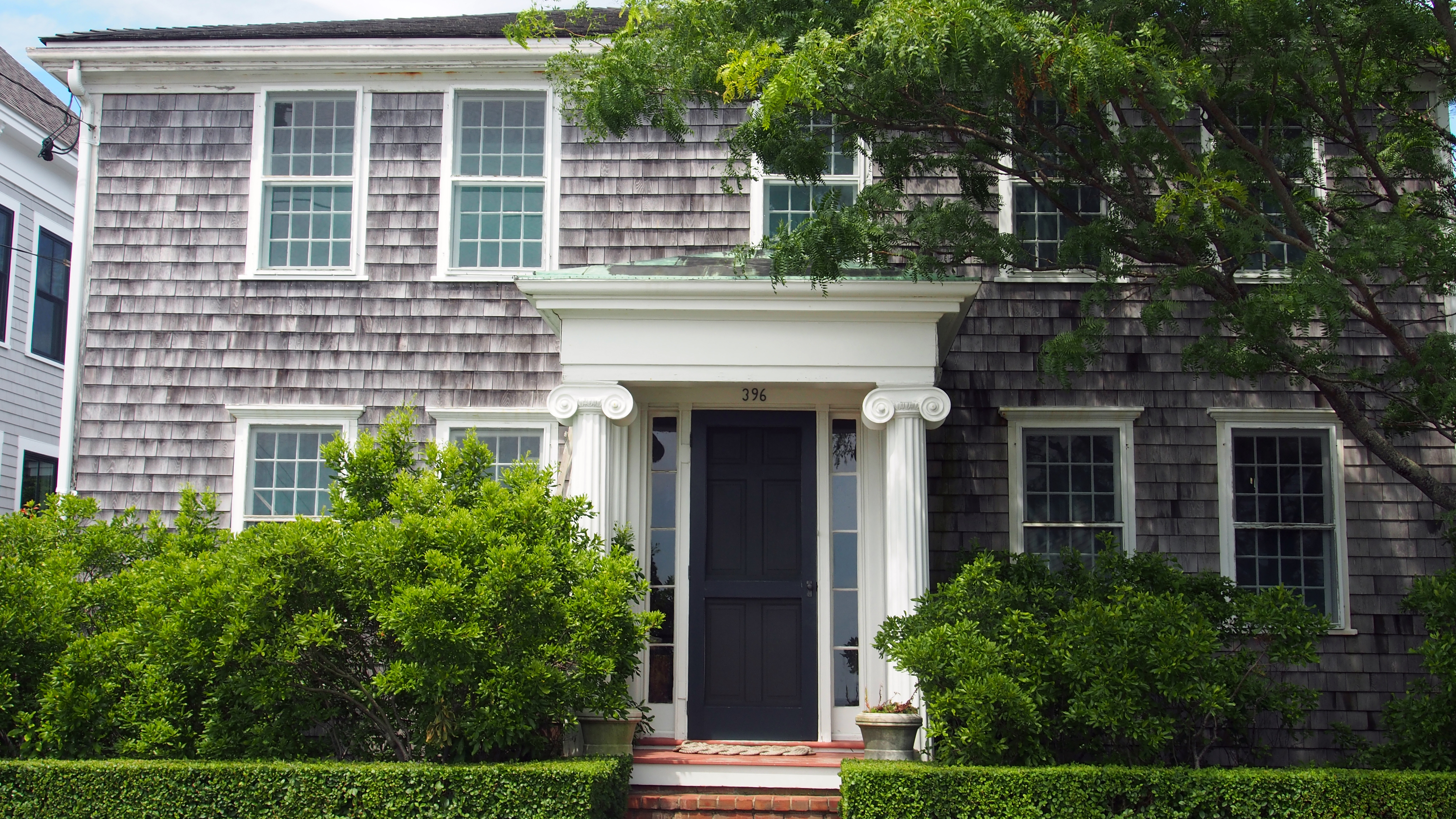
Photo courtesy of Propane Education and Research Council
More single-family residential builders will embrace hydronic heating systems as homebuyers who are already familiar with the benefits of energy-efficient tankless water heaters learn that these energy—and water-saving devices can also help heat their homes.
While forced-air hydronic heating is still in the early stages among single-family homebuilders, the technology appears more commonly in light commercial buildings such as townhomes, condominiums, and apartments, all of which can utilize the compact size of the tankless water heater/air handler combination. More single-family residential builders will embrace hydronic heating systems as homebuyers already familiar with the benefits of energy-efficient tankless water heaters learn that those energy- and water-saving devices can also help heat their homes. The energy efficiency of the two-appliance system can also play a role in sustainable design, as heating air with hot water is an efficiency double play.
Commercial
In commercial buildings such as large warehouse projects, the ability of radiant heating systems to deliver heat efficiently over large surface areas makes them a wise choice. The boom in e-commerce has only accelerated since the pandemic, driving continuing growth in the construction of large distribution centers and warehouses. These large buildings utilize a variety of heat sources, but in Radiant & Hydronics, George Youngvorst argues that radiant heating should be given more consideration. “The larger the building footprint, the more incentive there is to use radiant heating,” Youngvorst writes.
“A well-designed radiant system can more efficiently deliver heat over large surface areas than forced air. It is also much easier to create zones that regulate temperatures to be warmer in some areas and cooler in others. There are few to no obstacles for the shelving to work around, and the owner can ‘go up’ as high as needed without concern for air vents.” In addition, to find enough affordable space for large warehouses, companies are moving to where land is cheaper, which frequently means less-developed areas without natural gas infrastructure. With propane’s versatility, architects and building owners can meet the high energy demands of these buildings no matter where they’re located.11
Specialty Applications
Hydronic heating systems can also be used for specialty applications such as snowmelt systems, which are a vital safety amenity for many facilities but are often seen as an unnecessary luxury and value-engineered out of a project. For example, “Hospital access ramps, geriatric facilities, helipads, car wash entrances and exits, parking garages — all those [snowmelt applications] are centered on safety and trying to minimize insurance casualties,” says Kolyn Marshall, systemsengineering manager for Watts, which manufactures a variety of hydronic and electric products used for radiant heating and snowmelt systems andcontrols. Beyond safety, snowmelt systems have wide-ranging benefits, from reduced maintenance costs to regulatory compliance, less chemical runoff, and less damage to driveways and floors from salt and snow-removal equipment.12
Using boilers for pools provides more consistent pool temperatures, improves fuel consumption, and reduces maintenance. This is important because of the caustic environment of pools where chlorine and other harsh chemicals are used. “Per ANSI code, pool temperature must be maintained within .3° of a setpoint temperature. This is critical because as water temperature changes, so does the rate at which chlorine oxidizes.” Designers will engineer a hydronic heating system based on the amount of water in the pool, the surface area of the water, the ambient air temperature, flow rates, and the ability to maintain a precise setpoint temperature. 13
INTRODUCTION TO RADIANT HYDRONIC HEATING TECHNOLOGY14
Now, let’s explore radiant hydronic heating, including how the technology works and how it improves occupant comfort and energy efficiency. Radiant heating is the effect you feel from the warmth of the sun, or a fireplace that’s across the room. When radiant heating is located in the floor, it is called radiant floor heating. Radiantheating systems supply heat directly to the floor or to panels in a building's walls or ceiling (we will not discuss wall/ceiling heating in this course). The systems depend largely on radiant heat transfer, which means the delivery of heat directly from the hot surface to the people and objects in the room via infrared radiation.
Despite its name, radiant floor heating depends heavily on convection, the natural circulation of heat within a room as air warmed by the floor rises. There are three types of radiant floor heat: radiant air, hot water, and electric. In radiant-air floors, air is the heat-carrying medium, but air cannot hold large amounts of heat, so radiant-air floors are not cost-effective in residential applications and are seldom installed. 445Hydronic (liquid) systems use hot water as the heat-carrying medium and are the most popular and cost-effective radiant floors for heating-dominated climates.
Heated water is pumped from a boiler through tubing laid under the floor. It is possible to regulate room temperature by using zoning valves to control the flow of hot water through each tubing loop. Electric radiant floors typically consist of electric heating cables built into the floor, although some systems feature electrical matting mounted on the subfloor.
Electric radiant floors are usually cost-effective only if they include a significant thermal mass, such as a thick concrete floor. The electric utility company offers time-of-use rates, allowing the owner to "charge" the concrete floor with heat during off-peak hours. The EPA says, “If the floor's thermal mass is large enough, its heat will keep the house comfortable for eight to ten hours without any further electrical input. This saves a lot of money compared to heating at peak electric rates during the day.”
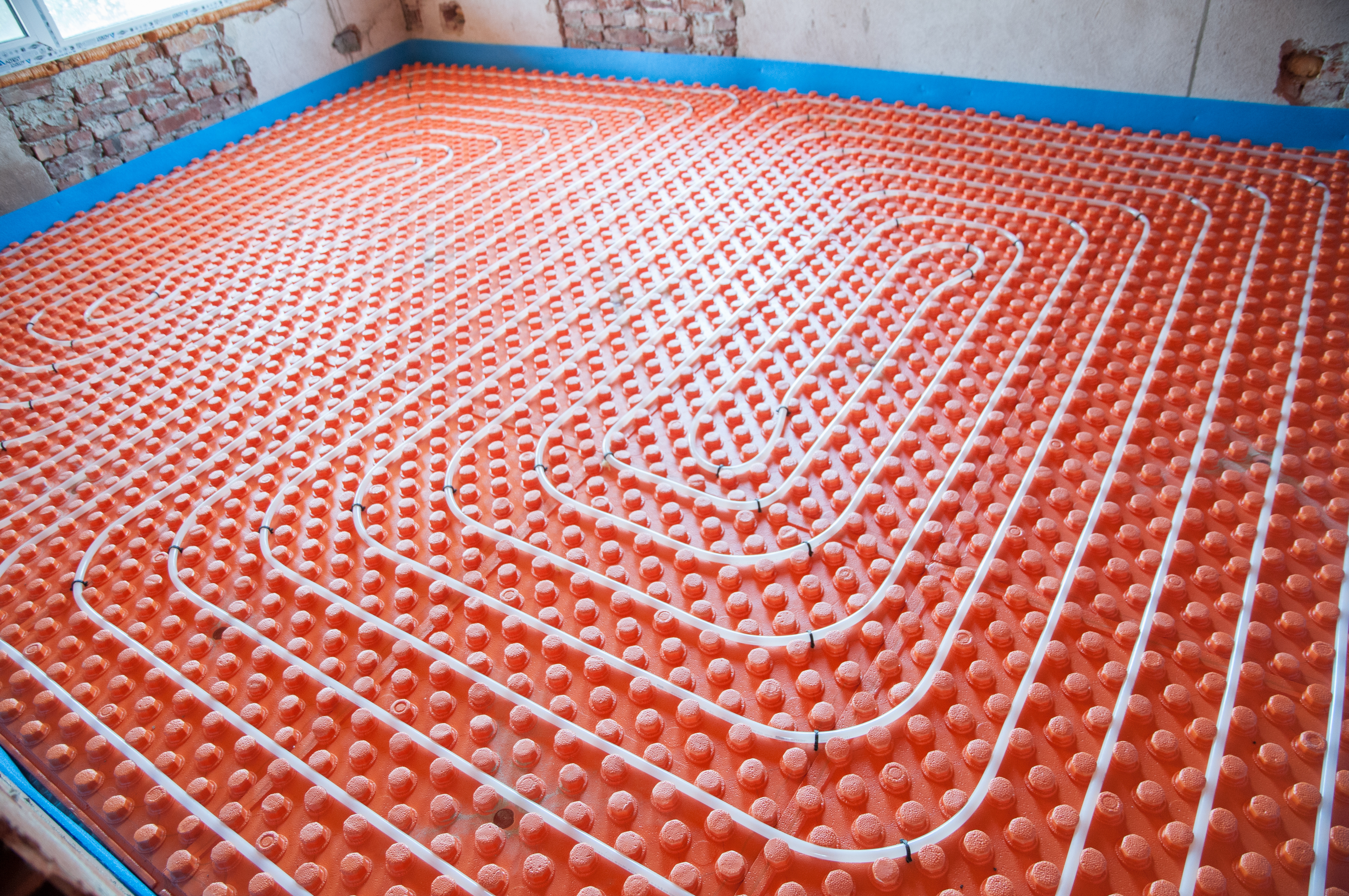
Photo courtesy of Propane Education and Research Council
Hydronic (liquid) systems use hot water as the heat-carrying medium. They are the most popular and cost-effective radiant floors for heating-dominated climates. Heated water is pumped from a boiler through tubing laid under the floor.
Installation Methods15
There are two methods of installing radiant floor systems: wet and dry. Wet installations use cables or tubing embedded in a concrete slab foundation or in a thin layer of lightweight concrete on top of a wooden subfloor. They are the oldest form of radiant floor system. In a dry installation, the radiant floor tubing is sandwiched between two plywood layers or attached under the finished floor or subfloor. The latter method is becoming more popular because the tubing is run in the air space beneath the floor, and a dry floor is faster and less expensive to install. That said, because dry floors also heat an air space, the radiant heating system needs to operate at a higher temperature. Types of Floor Coverings16
Ceramic tile is the most common and effective floor covering for radiant floor heating because it conducts heat well and adds thermal storage. Common floor coverings like vinyl and linoleum sheet goods, carpeting, or wood can also be used. Still, any covering that insulates the floor from the room will decrease the system's efficiency. A thin carpet with dense padding should be used if carpeting is desired. Only laminated wood flooring should be used — not solid wood, which is more likely to shrink and crack due to the drying effects of heat.
ADVANTAGES OF RADIANT HYDRONIC HEATING
We’ve already discussed some of the advantages of hydronic heating systems, but let’s cover some advantages specific to radiant hydronic.
Health and Comfort17
In a forced-air system, air is blown throughout the building to achieve a desired temperature, distributing allergens such as dust and can cause allergic reactions. To complicate matters, when air is heated above 130 degrees Fahrenheit in a conventional system, dust particles become more reactive and irritating to occupants because they are essentially burning on the heating elements (dust singe). Many owners choose radiant hydronic systems because they prevent dust singe and don’t distribute allergens such as dust and other particles in the air. In addition, radiant systems radiate heat so effectively that the thermostat can be lowered by 2–4 degrees Fahrenheit and still provide the warmth and comfort level of other systems.
The room may feel more comfortable because the system produces more natural heat, similar to solar radiation on the skin. Another benefit of radiant and hydronic systems is that temperatures are more consistent from the floor to the ceiling. This is not the case with a forced-air system, where temperatures typically differ 3–5 degrees between the floor and ceiling. This temperature difference between the head and ankles can influence perceived thermal comfort. “In computer simulations, laboratory experiments, and field studies, a clear difference is found in vertical temperature gradients between radiant and other heating systems. With radiant heating, practically no temperature differences are found between the floor and ceiling.”
Energy Efficiency
Unlike conventional systems such as baseboard and forced-air heating, radiant systems are more efficient. They eliminate duct losses, which can waste up to 30% of the energy in certain building types. They also deliver heat precisely where it is needed because transporting water via pumps is much more energy-efficient than transporting air via fans. The U.S. Department of Energy found: “A given volume of water can absorb almost 3,500 times more heat than the same volume of air, which means that small tubing can replace large, cumbersome ducting.
For example, a 3/4”-diameter flexible tube can deliver the same amount of heat as a 14-inch-by-8-inch rigid metal duct when both systems are operated under typical conditions. In addition, the radiant system usually reduces heating and cooling energy because the low-temperature hot water and high-temperature cold water help improve the heating and cooling efficiency of the corresponding equipment. As an added benefit, well-designed radiant systems are more comfortable than forced-air systems.”
INTRODUCTION TO FORCED-AIR HYDRONIC TECHNOLOGY — WITH A COMBI-BOILER
Now, let’s examine how forced-air hydronic technology works with both boilers and tankless water heaters and how it can help to save money and energy while improving occupant comfort. Hydronic forced-air heating isn’t a new technology. Still, it could be entering its prime, given the building industry’s increasing focus on comfort and the evolution of both tankless water heaters and combi-boilers. As efficiency and reliability continue improving, builders and contractors are increasingly interested in how those systems can be easily incorporated into hydronic forced-air heating systems. A residential condensing gas combination boiler (combi-boiler) provides space heating and domestic hot-water heating. With the new heating system, the air distribution essentially works like traditional systems. Instead of air blowing through the heat exchanger inside the furnace, the air is heated by a coil in the air handler filled with hot water from the combi-boiler.
The combi-boiler water exchanges its heat with the air blowing across the built-in coil atop the air handler on its way to being distributed through the house. Gail Johnson, a national account manager for Noritz America, described his installation in an article:18 The combi-boiler generates hot water at 160 degrees Fahrenheit, circulating at 2–3.5 gallons per minute to the coil. The water then returns to the combi at about 145 degrees. Consequently, the combi needs to raise the return water temperature by only 15 degrees, from 145 to 160, so it’s burning only about 20,000–40,000 Btus to keep the water at the desired temperature for space heating. The system replaced a traditional furnace that burned 80,000 Btus constantly during the heating season.
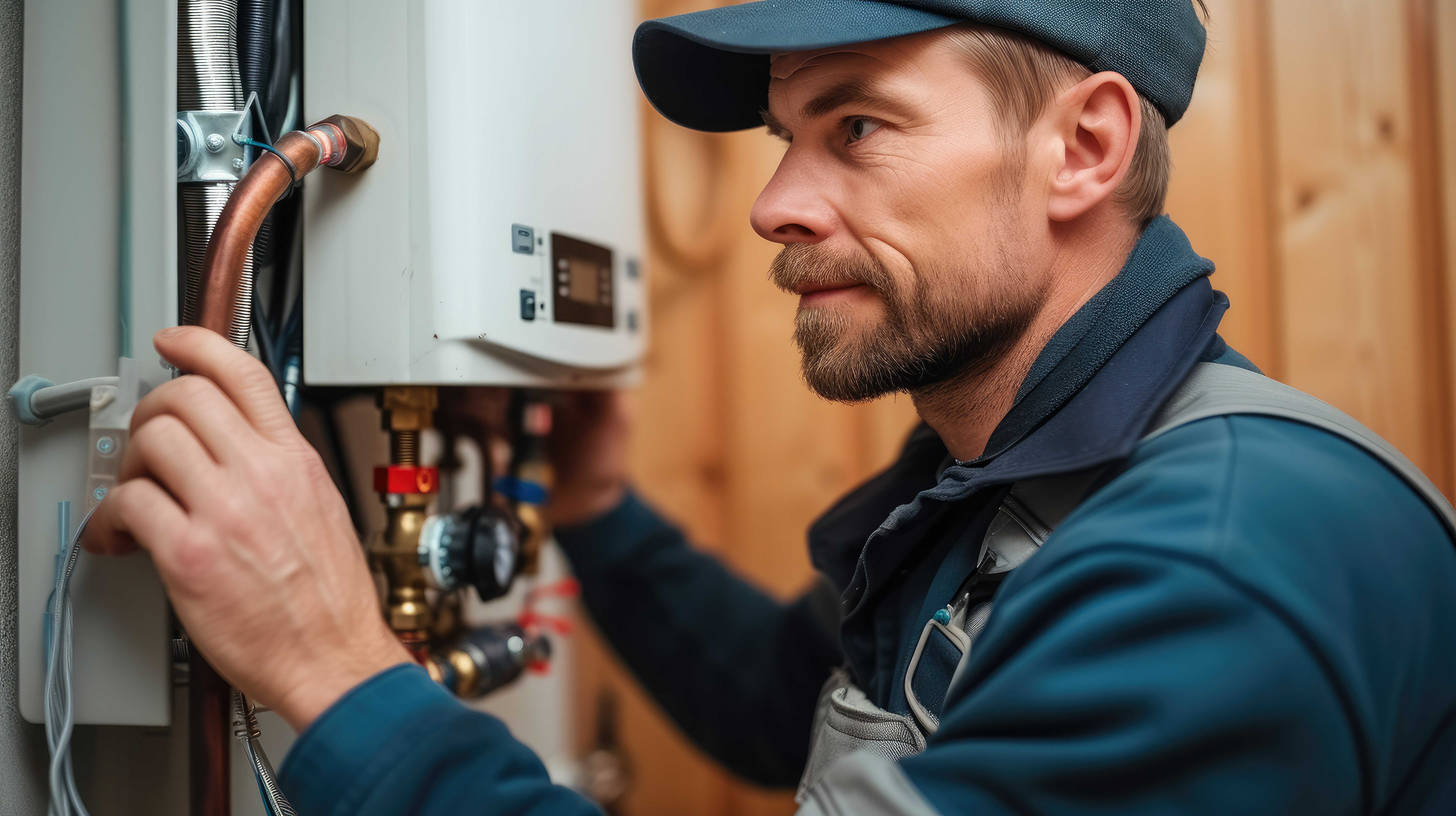
Photo courtesy of Propane Education and Research Council
The powerful heating energy provided by a tankless water heater to create domestic hot water can also be used to heat a home, as the market now offers dedicated hydronic air handlers that use tankless water heaters and boilers as a heat source.
ADVANTAGES OF A FORCED-AIR HYDRONIC WITH COMBI-BOILER
Forced-air hydronic systems with a combi-boiler are very efficient, with a 95% AFUE (annualized fuel utilization efficiency) versus the 80% AFUE of a standard gas furnace, which can provide significant cost savings. Further cost savings can be found in an air handler with a variable-speed motor, which saves electricity. These systems also offer the ability to use a single gas appliance to supply home heating and domestic hot water without sacrificing comfort or efficiency. With rebates available for combi-boilers in many markets, it’s a solution that contractors may want to monitor to provide an excellent experience for their clients.
Hydronic heat can also work well as a source of supplemental heat for buildings with a gas water heater and a heat pump. Green Building Advisor notes: “Most heat pumps use electric resistant heat to supplement the heat pump output when the temperature drops below the balance point. Electric resistance heat isn’t very efficient and can run up huge electric bills.”21 Hydronic heat can replace the excessive energy use of backup electric resistance heat.
INTRODUCTION TO FORCED-AIR HYDRONIC TECHNOLOGY — WITH A TANKLESS WATER HEATER
The popularity of tankless water heaters is growing significantly. The powerful heating energy provided by a tankless water heater to create domestic hot water can also be used to heat a home, as the market now offers dedicated hydronic air handlers that use tankless water heaters and boilers as a heat source. A tankless water heater is used instead of a combi-boiler supplying the hot water for a forced-air hydronic system. The units can meet heating capacities ranging from 17,000 to 77,000 Btus, allowing them to be effective alternatives to propane, gas furnaces, or electric backup heat.
A hydronic air handler borrows hot water from a tankless water heater, moves it through a coil to pick up the heat from the water, and blows it through the ductwork and into the house. By borrowing heat from a tankless water heater to deliver steady, comfortable space heating throughout the building, forced-air hydronic heating saves space and energy. The propane- or gas-fueled tankless water heater supplies unlimited hot water — unlike a traditional tank with just 50 or 75 gallons capacity. The air handler pumps a constant air flow past the coil and delivers steady, comfortable heat to the building without needing a fuel-fired furnace or an extra vent to the outside. Additionally, the tankless water heater can continue performing its job while heating the water for showers, sinks, dishwashers, and washing machines.
ADVANTAGES OF FORCED-AIR HYDRONIC WITH TANKLESS
A tankless water heater is more expensive than a traditional model with a tank. Still, some manufacturers offer the hydronic air handler for less than a comparable gas-powered condensing furnace. And while electric backup heat can send electric bills soaring during cold weather, hot water from a propane tankless water heater is typically much more affordable. While many homeowners love the hot air temperature provided by a furnace, a hydronic air handler offers a less-extreme heat to help avoid stratification, in which the air close to a duct is much warmer than space farther away. Some homeowners also report that their water-warmed heat is more even and less dry than heat radiated via a traditional gas furnace, which is ideal for cold climates. Homeowners can control the air temperature by setting a thermostat, just as they would with a conventional furnace.
Compared with a gas furnace plus water heater, tankless hydronic heating requires only one gas appliance, meaning fewer vents and gas connections to install. The crossover product fills a need when labor is hard to come by, as the dual technology has prompted some plumbers to get into the heating business and some mechanical contractors to add tankless water heater installation to their line of services. Hydronic forced-air heating can also address a common concern with electric backup heat: the smell. As we discussed earlier, the burning smell associated with auxiliary heat is typically caused by dust or lint burning off on the electric coil, a problem easily mitigated by hydronic air handlers, which aren’t exposed to the same high temperatures.
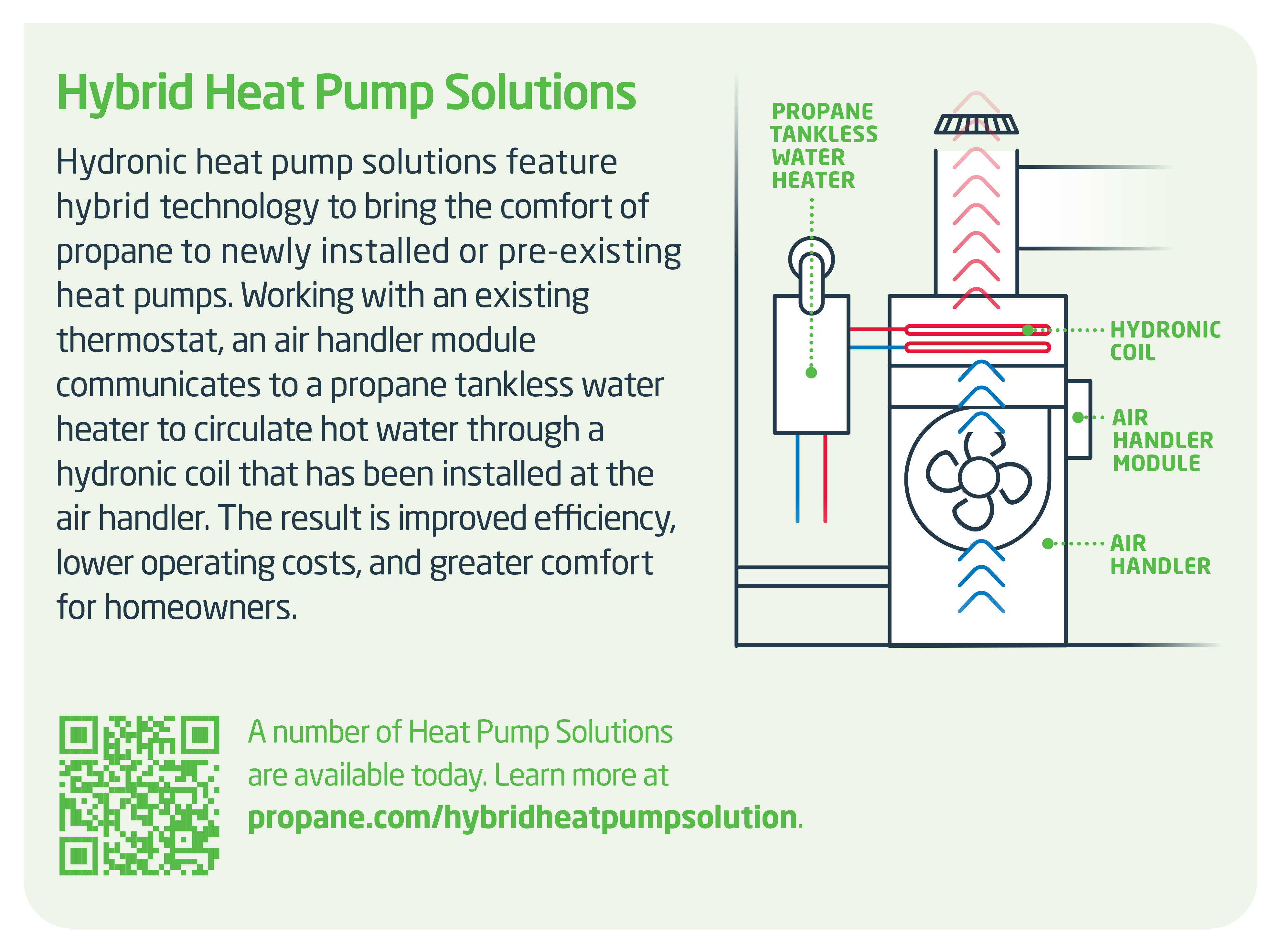
Installation is also easier because installers can adjust the unit's heat output by changing the blower speed, hot-water temperature, or flow rate. Each of those adjustments can help ensure the system uses the right amount of Btus for space heating. Some manufacturers’ tankless water heaters and boilers run on propane or natural gas, so they are ideal for applications that use propane as an energy source. The systems are versatile, as they can be installed in a new building or added to an existing home. Manufacturers of forced-air hydronic systems typically offer priority switches that satisfy domestic hot-water needs while maintaining space-heating performance. In addition, boilers can provide a second layer of functionality.
Tankless water heaters are connected to the air handler in an open-loop system, meaning the same hot water is used to heat the space and provide domestic hot water; a feature in the air handlers allows it to cycle every six hours to avoid stagnation. But certain jurisdictions don’t allow an open loop for heating, which is where boilers come in. Boilers have separate loops for domestic hot water and centralized heating, allowing you to use glycol for the heating loop. And because the temperature of each circuit is set separately, the systems generally don’t require a mixing valve to bring down the temperature of the hot water.
Since the air handlers are compact and available in outputs as low as 17,000 Btus, they are ideal for closet-style applications such as multifamily or townhome settings. They’re also a potential option for increasingly common super-efficient homes with low heating load except on the coldest days. Since the water heater is the source of heat for both the air and the water, hydronic systems are as efficient as the tankless water heaters they run on, which can achieve efficiency levels around 94%. Hydronic systems create no wastewater because they take the water used to heat the air and recirculate it back to the tankless water heater. By making the most efficient use of the energy source, hydronic forced-air heating systems with tankless water heaters offer an important tool for builders and architects to improve environmental performance and reduce the carbon footprint of their projects.
CONCLUSION
Propane-fueled hydronic heating technologies such as radiant hydronic and forced-air hydronic can improve the sustainability of buildings and the health and comfort of occupants. Both technologies maximize energy efficiency and improve thermal comfort with more consistent temperatures, comfortable humidity levels, and easier control. The case studies we’ve reviewed, ranging from residences to education facilities, demonstrate the breadth of applications for hydronic heating technologies and how they can be used in remote areas of the country not served by natural gas. Propane can be used not only for hydronic heating in these buildings but for domestic hot water; cooking appliances; and amenities such as fire pits, snowmelt systems, and pool heaters.


